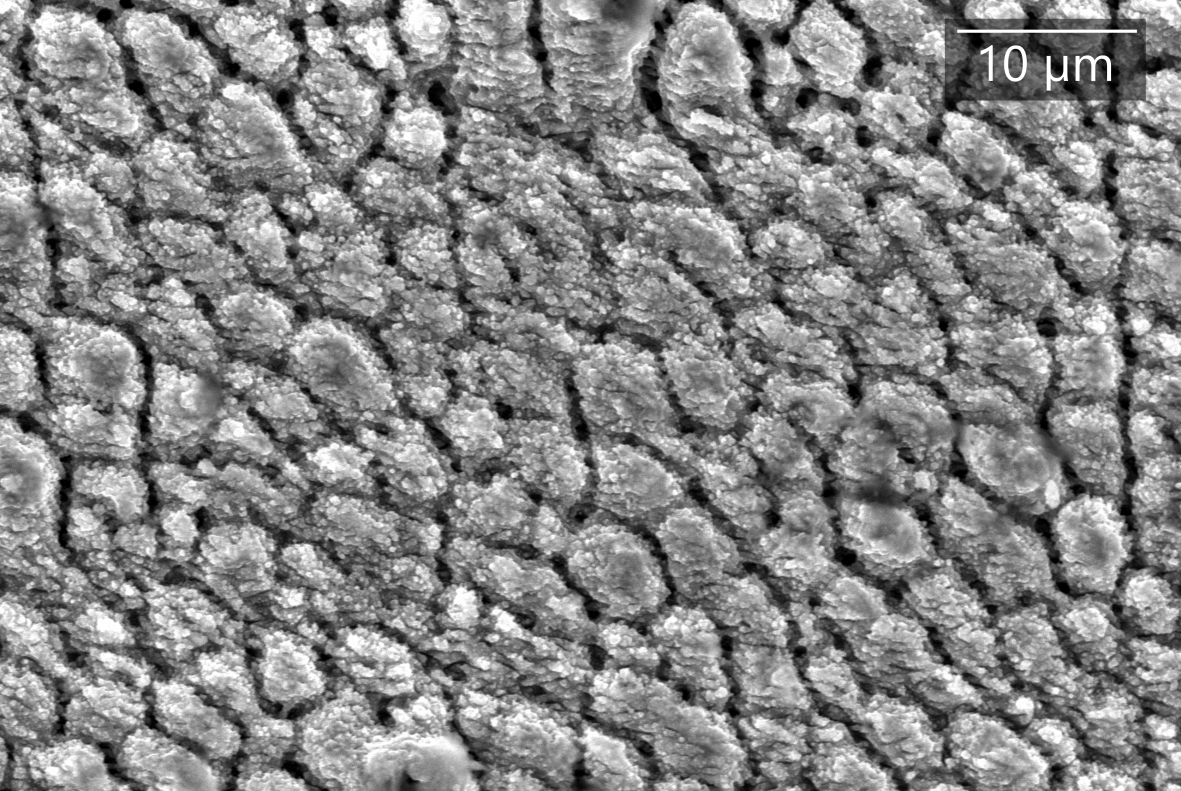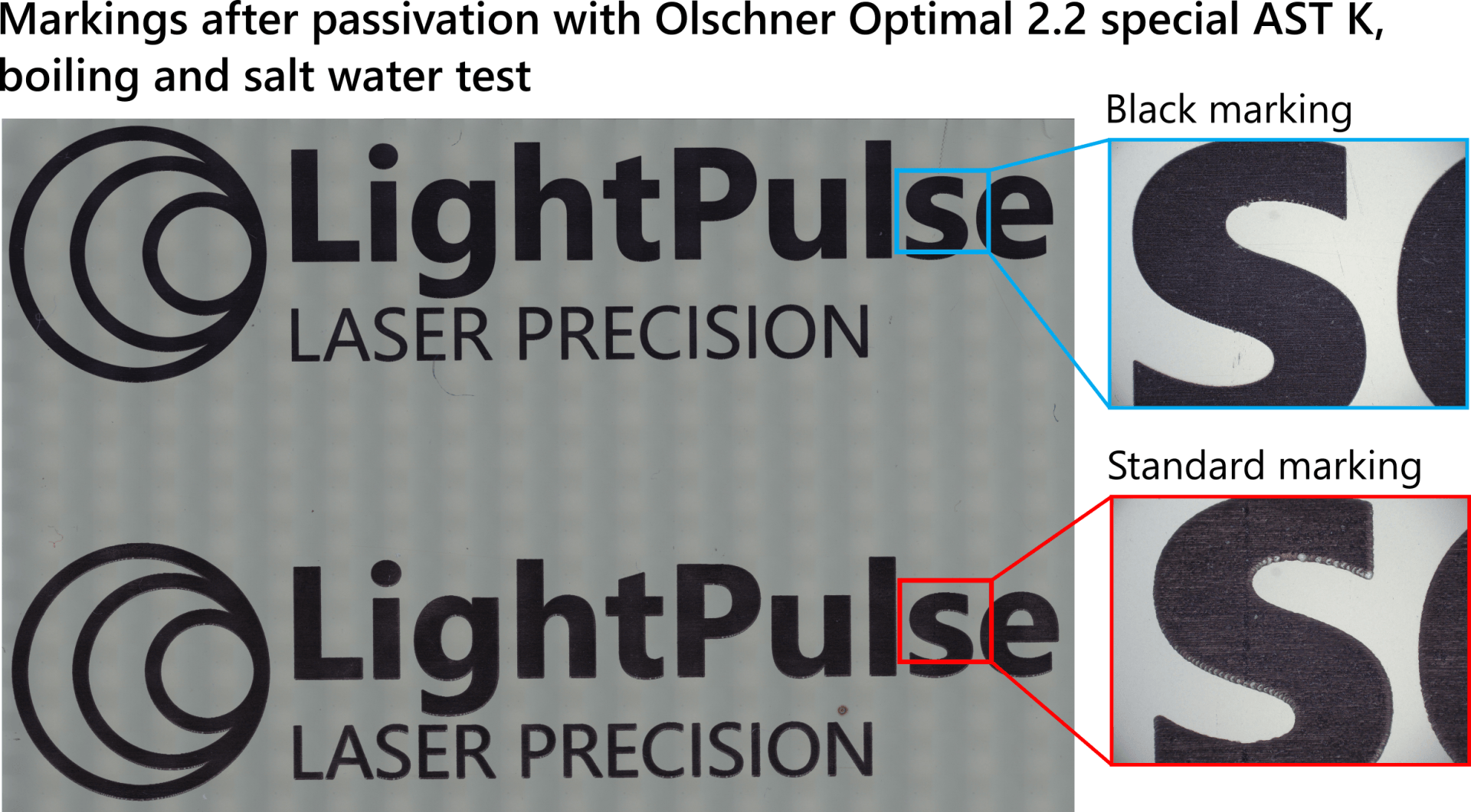Unique Device identification
Unambiguous marking of the UDI following theMedical Device Regulation (MDR)
Marking of the UDI with ultrashort pulse lasers
The ultrashort pulse laser as a flexible tool allows black marking
of metals such as steel and titanium at high contrast. The markings are corrosion resistant. The marked parts underwent various tests such as passivation, boiling in distilled water and a one-day storage in Ringer's solution. The ultra-short pulse laser is therefore ideally suited for marking the UDI in accordance with the new EU medical device regulation.
The Unique Device Identification (UDI)
On 25 May 2017, the EU Medical Devices Regulation (MDR)
came into force, with the three-year transition period ending on 26 May 2020. This makes it mandatory to label every medical device with a Unique Product Identification (UDI). The background to the introduction of the UDI is to improve patient safety, simplify product recalls and optimize market surveillance. The aim is to ensure clear traceability throughout the entire product life cycle. The UDI must be applied to the medical device, for example in the form of a marking, and should be readable by humans in plain text and by machines in the form of a bar code or 2D code. It is important that the UDI remains permanently readable throughout the entire product life cycle. This means that the UDI marking must withstand passivation processes, intensive use and repeated sterilisation. These requirements cannot be met with conventional laser markings generated with a nanosecond laser. Only the process of black marking with the ultrashort pulse laser
is able to produce a high-contrast and corrosion-resistant marking of the UDI at the same time.
Black marking with the ultrashort pulse laser
To create a black mark, the ultra-short pulse laser beam is moved over the workpiece with a scanner system. Self-organized structures are formed on the surface of the workpiece. If the processing parameters are set correctly, a surface structure is created which absorbs the light through multiple reflections instead of reflecting it. This results in a dark to black colour impression. Such a surface structure can be seen in the following picture.
A black marking is a strongly roughened surface structure with a superimposed micro- or nanostructuring. Thus, incident light is captured, so to speak, and not reflected. While in conventional laser markings on a steel surface, oxides are responsible for a large part of the dark color impression, in black markings this is achieved purely by the surface structure. This results in several advantages:
- Corrosion resistance: As long as the surface structure is preserved, the color impression is also preserved. Oxides have no negative effect.
- No influence of passivation: During passivation, oxides are dissolved on the material surface. As the surface structure is responsible for the colour impression during black marking, this impression is retained even after passivation.
- High contrast: On steel and titanium surfaces, a deep black marking is achieved which clearly stands out from the original surface.
- High precision: The ultrashort pulse laser is easy to focus due to its good beam quality. The focus diameters typically used are in the range of a few 10 µm, which means that even small structures can be marked precisely. Thanks to modern system technology with positioning camera, the marking can be placed on the workpiece with an accuracy of <10 µm.
Test of the black markings
To demonstrate the advantages of black marking, black markings generated with the ultrashort pulse laser at LightPulse
LASER PRECISION were tested for their color stability and corrosion resistance. This test consisted of the following test program:
- Passivation of the test parts with the passivating agents Citrisurf 2250 or Olschner Optimal 2.2 special AST K
- Boiling the test parts in distilled water
- Storage of the test parts in a saline solution
During the passivation process, any oxidation that may cause a dark colour impression is dissolved. Standard markings, which are based on this effect for marking, bleach out during passivation. Black markings keep their dark colour impression. The aim of boiling the parts and storing them in salt water is to test their corrosion resistance. Rusting of the parts should be avoided.
The result of the tests is shown in the following pictures. A black marking is compared with a standard marking (both generated with an ultrashort pulse laser). Thus the advantages of a black marking are made clear. The tested samples passivated with the passivating agent Citrisurf 2250 show a clear fading of the standard marking, especially when viewed with the eye. In the magnification, many areas can be seen which have not been sufficiently roughened to achieve a dark color impression solely by the surface structure. In contrast, the black marking remains black and rich in contrast even after the test program. The magnification shows that the black marking is homogeneously blackened. The surface structure is continuously designed so that incident light is not reflected. No rusting of the marking can be detected.
The result of the tests is shown in the following pictures. A black marking is compared with a standard marking (both generated with an ultrashort pulse laser). Thus the advantages of a black marking are made clear. The tested samples passivated with the passivating agent Citrisurf 2250 show a clear fading of the standard marking, especially when viewed with the eye. In the magnification, many areas can be seen which have not been sufficiently roughened to achieve a dark color impression solely by the surface structure. In contrast, the black marking remains black and rich in contrast even after the test program. The magnification shows that the black marking is homogeneously blackened. The surface structure is continuously designed so that incident light is not reflected. No rusting of the marking can be detected.
A similar picture is obtained for the specimens passivated with the passivating agent Olschner Optimal 2.2 special AST K. While the surfaces are less bleached when using this passivating agent even with the standard marking, the edges of the marking in particular become brighter. Even when using Olschner's passivating agent, the black marking remains high-contrast and rust-free.
The high contrast, corrosion resistance and high precision make black markings with the ultrashort pulse laser
the ideal process for marking the UDI
on medical devices.





